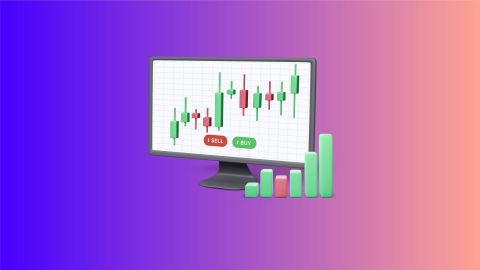How to calculate the put call ratio?
The PCR ratio is calculated by dividing the total open interest of outstanding put options by the total open interest of outstanding call options for a specific security or market. The open interest represents the total number of options contracts that have not been exercised or expired.
1. Based on open interests of a specific day
- The PCR is calculated by dividing the total open interest of outstanding put options by the total open interest of outstanding call options for a specific security or market.
PCR ratio formula
PCR = Total open interest of put options / Total open interest of call options
Example
Suppose we want to calculate the put call ratio for "XYZ Ltd," listed on the Bombay Stock Exchange (BSE).
- The total open interest for put options on XYZ Ltd is 5,000 contracts.
- The total open interest for call options on XYZ Ltd is 10,000 contracts.
Using the PCR ratio formula
PCR = 5,000 (Put options) / 10,000 (Call options) = 0.5
In this scenario, the put call ratio for XYZ Ltd is 0.5.
2. Based on the trading volume of a specific day
- Alternatively, the PCR ratio can be calculated using the trading volume of put and call options on a specific day. This method provides insights into the current market sentiment based on the day's trading activity.
Formula: PCR = Total trading volume of put options / Total trading volume of call options
Example
Let us consider the trading volume on a specific day for "ABC Ltd" on the National Stock Exchange (NSE).
- The total trading volume of put options on ABC Ltd is 3,000 contracts.
- The total trading volume of call options on ABC Ltd is 6,000 contracts.
Using the formula:
PCR = 3,000 (Put options) / 6,000 (Call options) = 0.5
In this scenario, the put call ratio for ABC Ltd on that specific day is 0.5.
Analysis of Put-Call Ratio
The put-call ratio (PCR) is a valuable indicator used to assess prevailing market sentiment. It compares the volume of put options to call options traded in a given market.
- Put options are typically used to hedge against market declines or to speculate on a falling market.
- Call options are used to hedge against market increases or to speculate on a rising market.
A PCR above 1 indicates a higher volume of put options relative to call options, suggesting a prevailing bearish sentiment. Conversely, a PCR below 1 signifies a higher volume of call options, indicating a bullish sentiment.
However, it is important to note that a PCR of 1 does not necessarily equate to a neutral market. Due to the inherent asymmetry between the potential gains and losses associated with put and call options, traders often have a preference for buying call options. As a result, a PCR of around 0.7 is generally considered a more accurate benchmark for assessing market sentiment.
A PCR above 0.7 or 1 suggests that a larger number of traders are purchasing put options, indicating a growing bearish sentiment. This could be driven by concerns about market volatility, economic uncertainty, or a perceived overvaluation of assets. Conversely, a declining PCR below 0.7 and approaching 0.5 signals a bullish trend, suggesting that traders are increasingly optimistic about the market's prospects.
Example of put-call ratio
Suppose the PCR for a particular stock is 2.0, which is a relatively high value. This suggests bearish sentiment. A contrarian trader might interpret this as an opportunity to buy the stock because the market may have become excessively pessimistic, and a rebound could be on the horizon.
Conversely, if the PCR is 0.5, indicating a bullish sentiment, a contrarian trader might consider selling the stock, anticipating a potential correction as market optimism may have reached unsustainable levels.
How to trade using a put-call ratio?
Trading using the put-call ratio (PCR) involves analysing the relationship between the number of put options and call options in the market. In the context of the Indian securities market, the following steps can be considered for a put-call ratio trading strategy:
1. Understanding put-call ratio (PCR)
- The put-call ratio is calculated by dividing the total open interest of put options by the total open interest of call options. It helps traders gauge market sentiment and potential future price movements.
2. Interpreting PCR values
- A high put-call ratio (PCR value above 1) indicates a bearish sentiment, suggesting that investors are more inclined towards buying put options, possibly anticipating a market decline.
- A low put-call ratio (PCR value below 1) implies a bullish sentiment, indicating a higher preference for call options, possibly anticipating a market rise.
3. Using strike price
- Assess the PCR based on the strike prices of options. Illiquid assets may have lower trading volumes, making the strike price a crucial factor. Analysing the strike prices can provide insights into market expectations.
4. Considering trading volume
- Evaluate the trading volumes of both put and call options. Look at the strike price and expiry date for a particular asset to determine the overall directional movement. Higher trading volumes can indicate stronger market consensus.
5. Examining open interest
- Open interest refers to the total number of outstanding contracts for a particular option. Apply open interest to the PCR to assess trading volume in both put and call options over a defined period.
- Increased open interest can suggest growing market participation and potential price movements. A decrease may indicate reduced market interest and potential reversal.
Interpretation of PCR
The put-call ratio can be interpreted in the following ways:
- PCR < 1: When the PCR is less than 1, it indicates that there are more open call contracts than put contracts, which can be seen as a bullish sentiment in the market. Traders and investors expect the underlying asset's price to rise.
- PCR > 1: When the PCR is greater than 1, it suggests that there are more open put contracts than call contracts, indicating a bearish sentiment. Traders and investors anticipate the underlying asset's price to fall.
- PCR = 1: When the PCR is close to 1, it implies a balanced sentiment in the market. Investors and traders do not show a strong bias either towards bullish or bearish views.
1. Time frame
PCR should be analysed over different time frames, such as daily, weekly, or monthly, to gain insights into short-term, and long-term market sentiment. Different time frames may reveal varying degrees of market sentiment and trends.
2. Historical data
Comparing the current PCR to historical values is crucial for determining significant shifts in market sentiment. An abrupt change in the PCR can indicate a potential reversal in the market.
Significance of put call ratio
The put call ratio holds significant importance for traders and investors:
- Market sentiment indicator – Helps gauge whether the market is bullish or bearish.
- Direction analysis – Assists traders in predicting price trends and placing directional bets accordingly.
- Contrarian perspective – Encourages traders to think independently and avoid herd mentality.
- Trading behaviour insight – Provides a broader view of how market participants are positioning themselves.
Limitations of put call ratio
While the put call ratio is a valuable tool, it has its limitations:
- Limited stock availability – Many company stocks do not have options, making PCR inapplicable for those stocks.
- Not always reliable – While it is a contrarian indicator, traders must consider other factors before making decisions.
- Requires additional indicators – PCR should be used alongside other technical and fundamental indicators for accurate insights.
- Reading challenges – Even minor shifts in PCR can indicate market movement, requiring careful interpretation.
- Investor-specific factors – Risk tolerance and financial goals should be factored in before acting on PCR trends.
PCR - The contrarian indicator
Traders use put-call ratio indicator as a contrarian indicator when it reaches extreme levels.
- A high PCR (e.g., 1.4) suggests that the market sentiment is overly bearish, which some traders see as a buying opportunity, anticipating a reversal.
- However, there is no fixed number that marks a market bottom or top. Traders monitor spikes or unusual shifts in the ratio to anticipate trend reversals.
- Historically, the NIFTY PCR oscillates between 0.8 and 1.3, with 0.8 as the lower bound (bullish signal) and 1.3 as the upper bound (bearish signal).
Example of Put-Call Ratio
Suppose the PCR for a particular stock is 2.0, which is a relatively high value. This suggests bearish sentiment. A contrarian trader might interpret this as an opportunity to buy the stock because the market may have become excessively pessimistic, and a rebound could be on the horizon.
Conversely, if the PCR is 0.5, indicating a bullish sentiment, a contrarian trader might consider selling the stock, anticipating a potential correction as market optimism may have reached unsustainable levels.
How to trade using a put-call ratio?
Trading using the put-call ratio (PCR) involves analysing the relationship between the number of put options and call options in the market. In the context of the Indian securities market, the following steps can be considered for a put-call ratio trading strategy:
1. Understanding put-call ratio (PCR)
- The put-call ratio is calculated by dividing the total open interest of put options by the total open interest of call options. It helps traders gauge market sentiment and potential future price movements.
2. Interpreting PCR values
- A high put-call ratio (PCR value above 1) indicates a bearish sentiment, suggesting that investors are more inclined towards buying put options, possibly anticipating a market decline.
- A low put-call ratio (PCR value below 1) implies a bullish sentiment, indicating a higher preference for call options, possibly anticipating a market rise.
3. Using strike price
- Assess the PCR based on the strike prices of options. Illiquid assets may have lower trading volumes, making the strike price a crucial factor. Analysing the strike prices can provide insights into market expectations.
4. Considering trading volume
- Evaluate the trading volumes of both put and call options. Look at the strike price and expiry date for a particular asset to determine the overall directional movement. Higher trading volumes can indicate stronger market consensus.
5. Examining open interest
- Open interest refers to the total number of outstanding contracts for a particular option. Apply open interest to the PCR to assess trading volume in both put and call options over a defined period.
- Increased open interest can suggest growing market participation and potential price movements. A decrease may indicate reduced market interest and potential reversal.
Conclusion
The put call ratio is a versatile tool that can offer valuable insights into market sentiment, serve as a contrarian indicator, and aid in risk management. However, it is essential to consider the PCR with other technical and fundamental analysis tools for a more comprehensive view of market conditions. Monitoring the PCR over various time frames and comparing it to historical data can help traders make informed decisions in the dynamic world of options trading.
Check out these interesting articles





